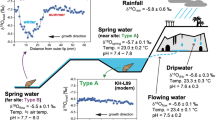Abstract
According to the evolutionary processes of stable oxygen isotope in lake water, a physical model has been established to calculate paleotemperature and used to quantitatively re-build the temperature sequences in the past 200 ka in Zoigê basin, eastern Tibet. The results show that in the Zoigê region the maximum temperature of the period equivalent to stage 7 in deep-sea stable oxygen record was 2.7êC higher than that of the present; in stage 6, it was 4.3êC lower and the value of the peak temperature of stage 5 was 5.2 êC higher than the present air temperature; in stage 4, the average temperature was 2-3êC lower; in stage 3, the curve of the temperature es-timated displayed the character of two peaks and one valley, and the value of the temperature dif-ference in the period was above 4êC. Moreover, by comparing the tendency of the curves of pa-leotemperature calculated and responsive stable oxygen isotope of authicarbonate, we also found that during stage 6 the environment in the Zoigê basin was extraordinary, inferring that the stage represented a transition period from warm-dry and cold-wet to warm-wet and cold-dry.
Similar content being viewed by others
References
Gasse, F., Arnold, M., Li, B. Y. et al., A 13000-year climate record from western Tibet, Nature, 1991, 353(24): 742.
Wu, J. L., Compositions of18O and13C in various carbonates of core RM in the Zoigê basin and climatic significance, Chinese Geographical Science, 1996, 17(1): 18.
Zhang, P. X., Zhang, B. Z., Qian, G. M. et al., The study of paleoclimatic parameter of Qinghai lake since Holocene, Quaternary Sciences (in Chinese), 1994, 3: 225.
Grafenstein, U. V., Erlenkeuser, H., Kleinmann, A. et al., High-frequency climatic oscillations during the last deglaciation as revealed by oxygen-isotope records of benthic organisms (Ammersee, Southern Germany), Journal of Paleolimnology, 1994, (11): 349.
Wei, K. Q., Lin, R. F., Paleoclimatic implications of oxygen isotope profiles of authigenic carbonates from inland closed lakes, Geochimica (in Chinese), 1995, 24(3): 215.
Wu, J. L., Wang, S. M., Pan, H. X. et al., Climatic variations in the past 140 ka recorded in core RM, east Qinghai-Xizang Plateau, Science in China (in Chinese), Ser. D, 1997, 27(3): 154.
Fritz, P., Fontes, J., Handbook of Environmental Isotope Geochemistry, Volume 2, the Terrestrial Environment, B, Amsterdam: Elsevier, 1986, 115–168.
Epstein, S., Buchsbaum, R., Lowenstam, H. A. et al., Revised carbonate-water isotopic temperature scale, Bull. Geol. Soc. Am., 1953, 64: 1315.
Shackleton, N. J., Non-equilibrium isotopic fractionation between seawater and planktonic foraminiferal test, Nature, 1973, 242: 177.
Zhang, P. Z., Wang, X. B., Wang, S. M. et al.,13C values and hydrogen index records in sediment organic matter of RH core of Zoigê basin, eastern Qing-Zang (Tibet) plateau and their environmental significance, Science in China (in Chinese), Ser. B, 1995, 25(6): 450.
Gonfiantini, R., Borsi, S., Ferrara, G. et al., Isotopic composition of waters from the Danakil Depression, Earth Planet. Sci. Lett., 1973, 18: 13.
Ji, L., Zhu, Y. X., Wang, S. M., Application of trace elements of ostracod to the environmental interpretation of core RM in Zoigê basin, in Formation, Environmental Evolution and Ecological System of Tibetan Plateau, Annuals (1995) ((ed. Qingzang Program Committee)(in Chinese), Beijing: Science Press, 1996, 123.
Guiot, J., Pons, A., Beaulieu, J. L. et al., A 140,000 year continental climate reconstruction from two European pollen records, Nature, 1989, (338): 309.
Zhang, X. P., Shi, Y. F., Yao, T. D., Various characteristics of 18O in precipitation in the Northeast Tibetan Plateau, Science in China (in Chinese), Ser. B, 1995, 25(6): 540.
Wang, Y. F., Wang, S. M., Xu, B. et al., Sedimentological evidence of the piracy of fossil Zoigê lake by yellow River, Chinese Science Bulletin, 1995, 40(18): 1539.
Yao, T. D., Thompson, L. G., Shi, Y. F., Climatic record in Guliya ice core since the last interglacial period, Science in China (in Chinese), Ser. D, 1997, 27(5): 447.
Wang, S. M., Xu, B., Environmental evolution of Zoigê basin since 900 kaB.P. and comparison study with Loess Plateau, Science in China, Ser. D, 1997, 40(3): 329.
Author information
Authors and Affiliations
Corresponding author
Rights and permissions
About this article
Cite this article
Wu, J., Wang, S., Shi, Y. et al. Temperature estimation by oxygen-stable record over the past 200 ka in Zoigê basin. Sci. China Ser. D-Earth Sci. 43, 577–586 (2000). https://doi.org/10.1007/BF02879501
Received:
Issue Date:
DOI: https://doi.org/10.1007/BF02879501




